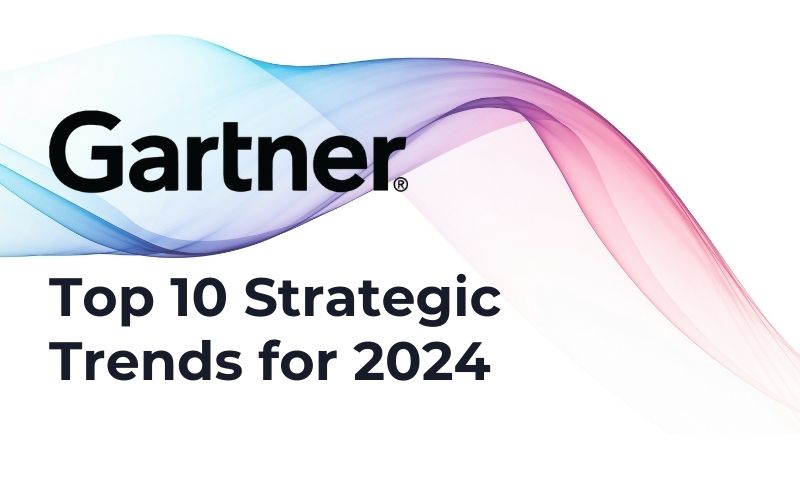Gartner's Top 10 Strategic Projections for Trends Shaping 2024 and Beyond
Every year, Gartner highlights essential trends, and it's that time again. This year, we'll look into ten trends that are more than just new – they're practical ways to assist businesses in the age of artificial intelligence. As you read, consider how these trends can help strengthen and advance your digital organization in a way that adds significant business value.
1. AI Trust, Risk and Security Management (AI TRiSM)
(AI TRiSM), standing for AI, Trust, Responsibility, and Security Model, acts as a guardian for AI systems, ensuring reliability and fairness. This crucial technological watchdog enhances project success, fosters decision-making consistency, and addresses biases in AI models while tackling issues of trust, responsibility, and security in AI development and use. According to Gartner, adopting TRiSM measures can lead to an 80% reduction in faulty information by 2026, significantly boosting decision-making accuracy for businesses.
2. Strengthening Cybersecurity Strategically with CTEM
Continuous Threat Exposure Management (CTEM) revolutionizes cybersecurity by offering a tailored and strategic approach to ongoing protection. This unique system adapts security checks to specific projects and potential threat areas, thinking proactively like malicious actors. CTEM goes beyond quick fixes, emphasizing smart, team-driven strategies for a safer digital world. Gartner predicts that by 2026, organizations implementing CTEM can reduce cyber breaches by two-thirds, showcasing its role as a strategic partner in bolstering digital security and resilience.
3. Crafting a Positive Future with Sustainable Technology:
Sustainable technology, a digital toolkit addressing environmental, social, and governance challenges, guides businesses toward responsible conduct. It safeguards the planet and enhances human rights while offering insights for overall performance improvement. According to Gartner, by 2027, 25% of CIOs will see their success tied to sustainable technology impact, reflecting a shift towards using technology for positive global change. This trend goes beyond tools; it's a commitment to leveraging technology as a force for creating a thriving world.
4. Leveraging Platform Engineering to Revolutionize Software Development
Platform Engineering transforms software development by establishing self-service internal platforms managed by dedicated teams, prioritizing the developer experience, and enhancing business value delivery. Gartner forecasts a transformative shift, with 80% of software engineering organizations forming internal platform teams by 2026. These teams will become crucial hubs for reusable services, components, and tools, significantly boosting efficiency and collaboration in the software development landscape.
5. Boosting Developer Productivity with AI-Augmented Development
AI-augmented development revolutionizes software engineering by significantly boosting developer productivity with AI technologies like generative AI and machine learning. These tools automate tasks such as code generation and design-to-code transformation, enhancing testing capabilities. By relieving software engineers from mundane coding tasks, AI-infused development tools empower them to focus on higher-level activities, fostering innovation in application design. According to Gartner, 75% of enterprise software engineers are expected to use AI coding assistants by 2028, a remarkable leap from less than 10% in early 2023.
6. Ensuring Industry Advancement with Customized Cloud Solutions
Industry Cloud Platforms (ICPs) are customized clouds for specific industries, seamlessly integrating various services like Software as a Service (SaaS), Platform as a Service (PaaS), and Infrastructure as a Service (IaaS). This tailored approach ensures adaptability to industry changes, providing efficient tools for IT leaders. ICPs offer a strategic edge, delivering customized outcomes for diverse industries and serving as toolkits for tech leaders. Gartner predicts that by 2027, over 50% of companies will adopt ICPs, highlighting their growing significance in industry-specific success.
7. Intelligent Applications for Better Experiences
Intelligent applications powered by AI and smart data enhance user experiences by working independently or collaborating with other apps. Thanks to Generative AI, these apps integrate insights into familiar platforms, predicting and suggesting actions for a uniquely personalized experience. Gartner projects that by 2026, 30% of new apps will leverage AI for personalized adaptive interfaces, a significant increase from the current less-than-5%. This trend foresees a future where applications serve as intuitive assistants, dynamically adapting to users for a more streamlined and personalized experience.
8. Transforming Accessibility of Generative AI to Fuel Business Growth
Democratized Generative AI, a transformative trend, democratizes advanced AI tools for widespread accessibility. This game-changing development enables the creation of various content forms, such as images, speech, and text, promising to automate tasks, boost productivity, cut costs, and unlock new growth opportunities. According to Gartner, by 2026, over 80% of enterprises are expected to embrace generative AI, marking a significant leap from the current less-than-5%. This shift signifies a future where a diverse range of professionals will harness these powerful tools, ushering in a new era of productivity and innovation.
9. Empowering Talent with the Rise of Augmented Connected Workforce
The augmented connected workforce trend maximizes human potential by seamlessly connecting people with intelligent technology. This strategy optimizes the value delivered by human staff through smart technology, workforce analytics, and skill augmentation. As workplaces evolve with automation and AI, the workforce must adapt to handle more complex tasks. Gartner predicts that by 2027, a quarter of CIOs will adopt augmented connected workforce initiatives, aiming to cut the time required to become proficient in key roles by 50%.
10. Shifting Economic Dynamics with the Rise of Machine Customers
The rise of machine customers signals a historic shift in economic dynamics, with nonhuman entities purchasing goods and services. By 2028, an estimated 15 billion connected products will act as customers, impacting trillions of dollars in purchases by 2030, according to Gartner. These intelligent machines engage in service requests, negotiations, purchases, and more tasks. Gartner predicts that by 2028, machines will replace 20% of digital storefronts designed for humans, transforming how businesses interact and conduct transactions in the digital world.
In examining Gartner's top tech trends for 2024, we have uncovered ways to strengthen your digital organization in the age of artificial intelligence. While delving into these trends, keep in mind their potential for growth and the ethical considerations they bring. With these ideas, we are moving toward a future where technology becomes more than a tool; it becomes a valuable partner in constructing a better digital world.









